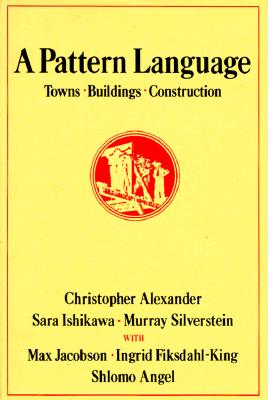"Individuals have no effective voice in any community of more than 5,000-10,000 persons."
 A Pattern Language: Towns, Buildings, Construction is a 1977 book on architecture, urban design, and community livability. It was authored by Christopher Alexander, Sara Ishikawa and Murray Silverstein of the Center for Environmental Structure of Berkeley, California, with writing credits also to Max Jacobson, Ingrid Fiksdahl-King and Shlomo Angel. Decades after its publication, it is still one of the best-selling books on architecture.[1]
A Pattern Language: Towns, Buildings, Construction is a 1977 book on architecture, urban design, and community livability. It was authored by Christopher Alexander, Sara Ishikawa and Murray Silverstein of the Center for Environmental Structure of Berkeley, California, with writing credits also to Max Jacobson, Ingrid Fiksdahl-King and Shlomo Angel. Decades after its publication, it is still one of the best-selling books on architecture.[1]
The book creates a new language, what the authors call a pattern language derived from timeless entities called patterns. As they write on page xxxv of the introduction "All 253 patterns together form a language." Patterns describe a problem and then offer a solution. In doing so the authors intend to give ordinary people, not only professionals, a way to work with their neighbors to improve a town or neighborhood, design a house for themselves or work with colleagues to design an office, workshop or public building such as a school. It includes 253 patterns such as 12 - Community of 7000 given a treatment over several pages where Pattern 12 on page 71 then goes on to state "Individuals have no effective voice in any community of more than 5,000-10,000 persons." It is written as a set of problems and documented solutions. This is a form that a theoretical mathematician or computer scientist might call a generative grammar. Written in the 1970's at University of California - Berkeley, it was influenced by the emerging language to describe computer programming and design. "A pattern language has the structure of a network" the authors write on page xviii. Thus each pattern may have a statement that is referenced to another pattern by placing that pattern's number in brackets, for example:(12) means go to the Community of 7,000 pattern. If the book had been written a few decades later, it probably would have been a web site, with each page being a pattern having hyperlinks to other patterns.
According to Alexander & team, the work originated from an observation that
"At the core... is the idea that people should design for themselves their own houses, streets and communities. This idea... comes simply from the observation that most of the wonderful places of the world were not made by architects but by the people".
—Christopher Alexander, A Pattern Language, front bookflap
Read more...



 Reports
Reports


 A Pattern Language: Towns, Buildings, Construction is a 1977 book on architecture, urban design, and community livability. It was authored by Christopher Alexander, Sara Ishikawa and Murray Silverstein of the Center for Environmental Structure of Berkeley, California, with writing credits also to Max Jacobson, Ingrid Fiksdahl-King and Shlomo Angel. Decades after its publication, it is still one of the best-selling books on architecture.
A Pattern Language: Towns, Buildings, Construction is a 1977 book on architecture, urban design, and community livability. It was authored by Christopher Alexander, Sara Ishikawa and Murray Silverstein of the Center for Environmental Structure of Berkeley, California, with writing credits also to Max Jacobson, Ingrid Fiksdahl-King and Shlomo Angel. Decades after its publication, it is still one of the best-selling books on architecture.

